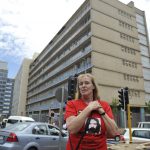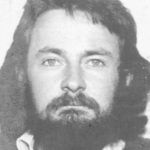Neil Aggett inquest: How the 10th floor worked
The reopened inquest into the activist’s death in 1982 has begun to shed light on the inner workings of the notorious interrogation floor of the apartheid-era John Vorster Square police station.
Author:
28 January 2020

What happened at John Vorster Square was supposed to stay within the confines of South Africa’s most notorious apartheid-era detention and torture site. That was the message made clear to former Security Branch member Joseph Nyampule when he first reported for duty to the office of the former head of the security police, Major Arthur “Benoni” Cronwright, in 1977.
In evidence given on Monday 27 January during the reopened inquest into the death of activist Neil Aggett, before Judge MA Makume at the Johannesburg high court, Nyampule recalled that Cronwright told him “what happened at John Vorster Square was confidential and I could not disclose anything to anyone”.
Nyampule’s evidence also detailed the strict security measures in place to keep the offices and work of the Security Branch separate from the rest of the police station. These included restricted areas, code systems and bells to ensure that access to the ninth and 10th floor offices was strictly controlled.
Nyampule, who is now retired, was 24 years old when he first arrived at John Vorster Square. His superiors impressed upon the young officer that the political detainees held in the station’s second-floor cellblock were dangerous, anti-government agitators who could kill him and with whom he should have the absolute bare minimum of communication. This was a rule Nyampule’s superiors would enforce by monitoring conversations in the cellblock through the use of intercoms. These conversations were then relayed to Cronwright and his officers on the ninth and 10th floors.
Related article:
The warnings and scaremongering led Nyampule to expect to be confronted with “dangerous-looking people”. But when their cells were opened, he recalled, his “expectations were shattered” as he saw only “men who were no different to other people”, many of whom “spoke English and were educated”.
Nyampule was posted to the male wing of the political detainee section of the cells, where he worked “normal office hours” and where members of the Security Branch were not present after hours. He was not part of the mainly white teams who conducted interrogations on the 10th floor, although it was part of his job to escort detainees from their cells to this floor.
Unlikely scenario
The purpose of Nyampule’s evidence, which he began giving on Friday 24 January and continued delivering on Monday, is to cast doubt on the official version of the events surrounding Aggett’s death that the Security Branch gave during the initial inquest in 1982. Nyampule testified that detainees were not permitted anything in their cells other than the clothes they were wearing, the bedding provided for them and a Bible.
Any other items, such as additional reading material, cigarettes or sweets, had to be requested and brought to them by officers from the room behind the charge office where their personal belongings were kept. Aggett’s possession of the kikoi he was alleged to have used to hang himself would thus have been in contravention of regulations and, in Nyampule’s opinion, highly unlikely.
Nyampule also testified that members of the police’s uniform branch patrolled the cells 24 hours a day, seven days a week, making it “impossible” – as stated in the original inquest – that no patrols occurred between 10.30pm and 1.30am on the morning of 5 February, when Aggett’s body was discovered hanging lifeless from the bars of cell 209.
Regulations governing the treatment of detainees allowed for visits by the district surgeon and a magistrate. But Nyampule recalled that in instances where detainees had sustained noticeable and severe injuries during their interrogation, they were kept from seeing these officials until they were deemed in a suitable enough state not to cause any concern or attract suspicion.
Related article:
Nyampule further testified that during his time as a Security Branch officer attached to the political detainee wing of the cells, nearly all of the many detainees he saw reported some sort of complaint of injuries sustained during interrogation. These included bruising and abrasions from handcuffs or leg irons, swollen feet, being made to stand or sit in stress positions for hours on end and complaining of physical assault by Security Branch members.
The former officer told Makume that, contrary to their claims during the initial inquest, members of Cronwright’s investigation team had their own keys and unmonitored access to the second-floor cells and would move detainees around at night and take them up to the 10th floor for interrogation.
‘Too friendly’
Nyampule also remembered an incident involving former ANC spokesperson Carl Niehaus during his detention in the 1980s. Arriving at the cellblock, Nyampule was met by his superior, Sergeant McPherson, who told him that Niehaus had attempted suicide and sent him to the 10th floor to report this to Cronwright. When Nyampule returned, he saw Niehaus being taken away on a stretcher and realised that McPherson had sent him to the 10th floor as a ploy to “hide something from me”.
Over years of working in the political wing of the cellblock and interacting with detainees, Nyampule said that he “became increasingly concerned about the treatment of detainees” and it seemed to him that “they were in danger of severe injury, even death”. He added that this made him “frightened for the sake of the detainees and for myself as I realised that if I was suspected of wrongdoing, I could be at risk.” He recalled that Cronwright once reprimanded him for “being too friendly with the detainees” and as a result, he “took a step back to make sure that I did not arouse further suspicions”.
Nyampule said he came into contact with Aggett during the doctor and trade unionist’s 70-day period of detention and interrogation at John Vorster Square. He remembered Aggett telling him he was being forced to rewrite his statement repeatedly without meeting the satisfaction of the Security Branch, but said Aggett never complained of injuries to Nyampule. Neither did Nyampule observe any injuries in his few interactions with Aggett.
When he learned of Aggett’s death, Nyampule said he was surprised to hear that Aggett had been in possession of the kikoi in his cell and that there was no subsequent disciplinary hearing into how the item had made its way into his cell.
Fear and distrust
Racial discrimination was used within the Security Branch to ensure that black members had little involvement beyond the practical with the detainees in their care. Investigations and interrogations were the domain of white officers, who treated their juniors and black colleagues with disdain and made sure they knew who the real bosses in the fight for their believed God-given rights of white South Africa were at all times.
Nyampule told the court that “black officers were treated like children. We had to do what we were told and had no sense of power and control. Black commissioned officers were subservient to the most junior white members.” He added that he learnt to “obey all the rules and policies out of fear of becoming a victim like the detainees. The black officers feared the white SB [Security Branch] officers. No one trusted each other. We all did what we were told to do and did not confide our inner feelings to one another.”
Related article:
Nyampule was scheduled to undergo cross-examination on Tuesday 28 January before the inquest moved on to hear testimony from former detainees, including Barbara Hogan, Firoz Cachalia and Frank Chikane, who were detained at the same time as Aggett.
The former officer’s testimony may not shed much light on the exact circumstances of Aggett’s detention. But it has certainly helped shed light on the dark shadows of the police station’s nefarious 10th floor and the men who worked there under the mistaken belief that whatever they did and whatever happened while they were doing it, what happened at John Vorster Square would stay in John Vorster Square.



